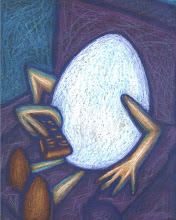What a better way to reminisce about past Christmas' than to look at the old Victorian graphics. When we think of the original greeting cards, we think of Louis Prang,
whether we realize it or not. His graphics were on some of the very
first Christmas greeting cards.
This time period was the beginning of one of the most creative times for printers. Some printers would even design their lithographs while working at the press. The process of lithography revolutionized the printing industry and allowed printers to become artists again. This time with an abundance of color and means of expression. The way pencil on a stone canvas allowed them to draw and paint at the same time. They could use a full array of colors and this is something they could never do before which allowed many artists to creatively express themselves while mass producing their works for the general public.
Louis Prang was one of those who mastered the technique of color lithography. He created thousands of images that reflect the Victorian era which was at the final end of the Industrial Revolution. Society was excited about all the new technology, especially with the support of the queen in the Arts and Crafts movement. We were mass producing so many goods with beautiful labels on the containers. These labels were so beautiful the average mom would soak the containers in water and then carefully pull the labels off and place them in albums for viewing. In fact, this is how the art of scrap booking began.
Louis did very well for himself making these beautiful color labels along with other advertisements, maps and eventually Christmas cards. He established his own advertising firm with another artist partner and traveled to Germany to master the craft of color lithography.
There's another reason that Louis Prang reminds me of Christmas. Christmas reminds me of art supplies because I usually received at least one art kit during the holiday season as a child. Louis had children as well and like most father artist, he was concerned about his kids getting into his art supplies. Most art supplies (even today) are highly toxic so they could harm a small delicate toddler. Louis was aware of this and through necessity, created the first line of non-toxic art supplies for children. We still use his watercolors today in most elementary schools. Remember the old, long metal case with Prang on the cover? When you opened it up there were 8-10 watercolor cakes with a thin plastic brush on one side. The back of the cover had water wells for mixing your paints. Everything the child needed to create a masterpiece was efficiently provided in this one little case without a single harmful toxin involved.
So we can see how Christmas, Prang, Children, toys and creativity all come together on one of the most special days of the year. Now, go get your watercolors be a child again!
This image is part of public domain
{{PD-US/layout
| text = ''This media file is in the '''[[w:public domain|public domain]
]''' in the [[United States]].
This applies to U.S. works where the copyright has expired, often because its first
[[w:publication|publication]] occurred prior to January 1, 1923.
See [http://copyright.cornell.edu/resources/publicdomain.cfm this page]
for further explanation.| warning text =
This image might not be in the public domain outside of the United States;
this especially applies in the countries and areas that do not apply the
[[w:rule of the shorter term|rule of the shorter term]]
for US works, such as Canada, mainland China (not Hong Kong nor Macao),
Germany, Mexico, and Switzerland.
The creator and year of publication are essential information and must be provided.
See [[w:Wikipedia:Public domain|Wikipedia:Public domain]] and
[[w:Wikipedia:Copyrights|Wikipedia:Copyrights]] for more details.''
| lang = {{subst:SUBPAGENAME}}
}}<noinclude>{{translated tag|license}}</noinclude>
 Medieval castles were not glamorous. They served a function and the earliest castles that are still in tact today have been useful in modern wars. In fact, there were several castles used by the allies in WW2.
Medieval castles were not glamorous. They served a function and the earliest castles that are still in tact today have been useful in modern wars. In fact, there were several castles used by the allies in WW2. 

![{{PD-US/layout | text = ''This media file is in the '''[[w:public domain|public domain]]''' in the [[United States]]. This applies to U.S. works where the copyright has expired, often because its first [[w:publication|publication]] occurred prior to January 1, 1923. See [http://copyright.cornell.edu/resources/publicdomain.cfm this page] for further explanation. | warning text = This image might not be in the public domain outside of the United States; this especially applies in the countries and areas that do not apply the [[w:rule of the shorter term|rule of the shorter term]] for US works, such as Canada, mainland China (not Hong Kong nor Macao), Germany, Mexico, and Switzerland. The creator and year of publication are essential information and must be provided. See [[w:Wikipedia:Public domain|Wikipedia:Public domain]] and [[w:Wikipedia:Copyrights|Wikipedia:Copyrights]] for more details.'' | lang = {{subst:SUBPAGEThis image is part of public domain {{PD-US/layout | text = ''This media file is in the '''[[w:public domain|public domain]]''' in the [[United States]]. This applies to U.S. works where the copyright has expired, often because its first [[w:publication|publication]] occurred prior to January 1, 1923. See [http://copyright.cornell.edu/resources/publicdomain.cfm this page] for further explanation. | warning text = This image might not be in the public domain outside of the United States; this especially applies in the countries and areas that do not apply the [[w:rule of the shorter term|rule of the shorter term]] for US works, such as Canada, mainland China (not Hong Kong nor Macao), Germany, Mexico, and Switzerland. The creator and year of publication are essential information and must be provided. See [[w:Wikipedia:Public domain|Wikipedia:Public domain]] and [[w:Wikipedia:Copyrights|Wikipedia:Copyrights]] for more details.'' | lang = {{subst:SUBPAGENAME}} }}<noinclude>{{translated tag|license}}</noinclude>](https://blogger.googleusercontent.com/img/b/R29vZ2xl/AVvXsEgtG8YRmZwtx_psFL_qTd0i-EhxNg48wgZHTlsHAxhEU9bYWaPn15mDO5fWGq5FFgcl6px_moq_POL9TL7R7OWkGUjqNVR2ykQn-VRgws9o8_A9oB0qqA4HU_GBIDGm0sah-33zsiBTQro/s1600/Christmas_card2_byLouisPrang.png)





